T. I. LIFE SUDOKU PUZZLE FOR AUGUST 2017
Last month, the bonus puzzle was in quite a different format. The given answers were not in a format, where they were in a mirror-image placement, from top-to-bottom and side-to-side. This, of course, is what you see with most published Sudoku puzzles. To be consistent with current times, we’ll call this a Fake Rule (not fake news). There are two consistent rules: first; each row, column & box must contain all numbers 1-9. Secondly; there can only be one solution to a puzzle to be a valid puzzle. (If you review the previous article, regarding Gordonian Rectangles & Polygons, you will see that this second rule spawns a unique advanced technique that can really be helpful in many puzzles.)
Puzzle #28 below is an interesting puzzle for a couple of reasons …
· There are a limited number of given answers, 17 to be exact, which is the same number as the bonus puzzle last week.
· This puzzle also does not follow the “fake rule” that the given numbers must be placed in a mirror image side-to-side and top-to-bottom.
· It is probably one of most challenging puzzles you will ever encounter
· Like all puzzles it has a weakness, a situation that if discovered, gives you the upper hand in its solution.
So please give it a whirl, and for backup we will go through step-by-step to discover this “weakness” and solve the puzzle. First, we will revisit the approach as discussed in my first 6 T. I. Life articles.
|
DAN’S 8 STEP APPROACH TO SOLVING ALL SUDOKU PUZZLES
Once you have completed the puzzle, to the extent that you have filled in all obvious answers and have written all potential options across the top of the unsolved cells (PUZZLE PREPARATION), Dan recommends the following Steps to complete the puzzle.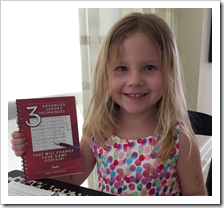
See TI Life Puzzle Preparation:
Step 1: Sudoku Pairs, Triplets and Quads – September 2015
Step 2: Turbos & Interaction – October 2015
Step 3: Sudoku Gordonian Rectangles and Polygons – November 2015
Step 4: XY-Wings & XYZ Wings – December 2015
Step 5: X-Wings – January 2016
________________
Step 6: DAN’S YES/NO CHALLENGE
Step 7: DAN’S CLOSE RELATIONSHIP CHALLENGE
Step 8: AN EXPANSION OF STEP 7
Steps 1-5 are relatively common techniques and are explained in the TI LIFE articles per above. Steps 6-8 are covered in detail, in Dan’s book.
Also see Sudoku Puzzle Challenge… February 2016, Sudoku Puzzle Challenge–March 2016, Sudoku Puzzle Challenge–April 2016, May 2016, June 2016, July 2016, August 2016, September 2016, October 2016, November 2016, December 2016, January 2017, February 2017, March 2017 , April 2017, May 2017, June 2017 and July 2017
As a reminder, the basic rules of Sudoku are that the numbers 1-9 must be contained and cannot be repeated in a row, column, or box, and there can only be one solution to the puzzle.
|
|
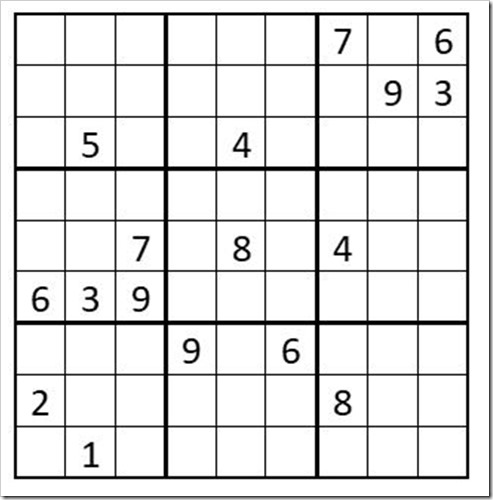
Puzzle #28
|
PUZZLE PREPARATION
Prior to utilizing techniques first complete the 4 Steps of Puzzle Preparation …
1. FILL IN OBVIOUS ANSWERS
2. FILL IN NOT-SO-OBVIOUS ANSWERS
3. MARK UNSOLVED CELLS WITH OPTIONS THAT CANNOT EXIST IN THOSE CELLS
4. FILL IN THE OPTIONS FOR THE UNSOLVED CELLS
OBVIOUS ANSWERS … Start with the 1’s, to see if there are any obvious 1-choice answers. Then navigate through the 2’s through 9’s.
The first obvious answer is C8R1=4 (cell in column 8, row 1); C7R2=5. That’s it! Now your grid should look like Example #28.1 below:
|
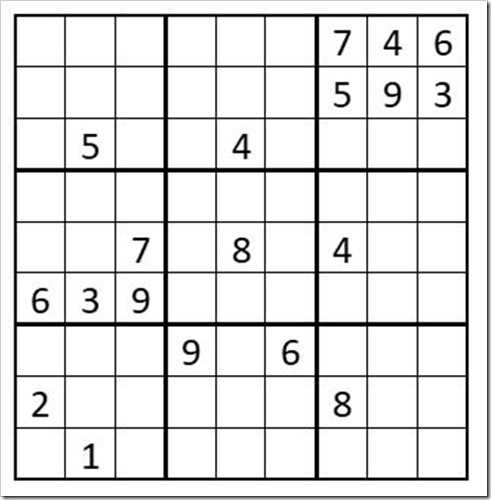
Example #28.1
|
NOT-SO-OBVIOUS ANSWERS … none!
NUMBERS IN CELLS THAT CANNOT EXIST …
In box 3 (upper right grid of 3x3 cells) C7R3, C8R3 & C9R3 can contain only the digits 1,2 & 8; therefore, a 1,2 & 8 cannot exist in any other cells in row 3, specifically C1R3, C3R3, C4R3 & C6R3. So, we will just take that into account when we indicate the options for those cells.
In box 4 the number 4 can only exist in cells C1R4, C2R4 or C3R4; therefore, a 4 cannot exist in C4R4 or C6R4. Indicate this by placing a small 4 in the bottom of these 2 boxes.
In box 4 an 8 can only exist in C1R4, C2R4 or C3R4; therefore, an 8 cannot exist in C8R4 or C9R4.
In box 8 an 8 can only exist in C4R9 or C6R9; therefore, an 8 cannot exist in C1R9 or C3R9.
FILL IN THE OPTIONS FOR THE UNSOLVED CELLS …
As you begin filling in the options for the unsolved cells you notice that C2R5=2 (only option remaining for this cell). Also, C7R3 & C7R6 form an obvious pair 12, so be sure to process (a 1 & 2 cannot exist in any other unsolved cell in column 7). Because of this last step you find that C7R7=3.
Now your grid should look like Example #28.2 below:
|
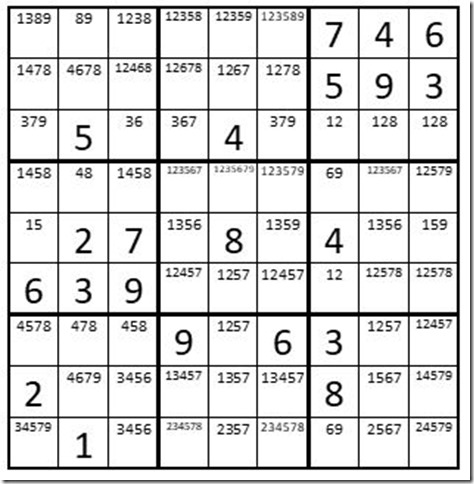
Example #28.2
|
Your reaction may be “that is a total unsolvable mess”! That was my reaction at first, especially since there are no Step 1-5 clues!
STEP 6: DAN’S YES-NO CHALLENGE
There are 3 circumstances that establish the potential for a Step 6 exercise:
1. Look for just 2 unsolved cells in a box that contain the same option and these 2 cells are not in the same row or column.
2. Look for just 2 unsolved cells in a column that contain the same option and these 2 cells are not in the same box.
3. Look for just 2 unsolved cells in a row that contains the same option and these 2 cells are not in the same box.
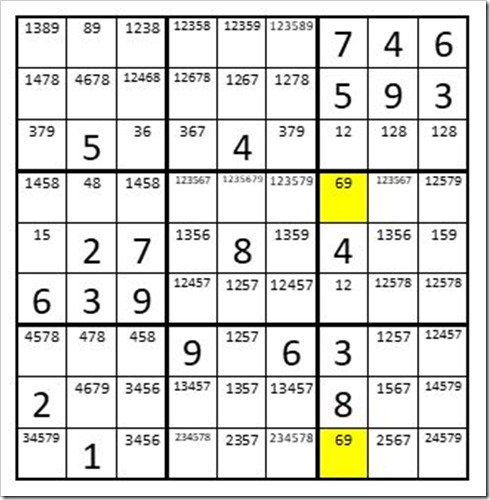
Example #28.3
|
After examining the 1-5’s we find no Step 6 clues. Now we will focus on the 6’s. In Example #28.3 above we have highlighted C7R4 & C7R9 in yellow. These will be our “starter cells” for a wild Step 6 ride!
You will agree that one of these highlighted cells in column 7 must be a 6. We will try to prove that regardless of which cell in column 7 is a 6, there is a cell (or cells) that cannot be a 6. We will start with C7R9 and assume it is a 6. Put a “Y” for yes in that cell. You can plainly see that if C7R9 is a 6, C3R9 cannot be a 6. Put a “N” for C3R9.
Next, we will assume C7R4 is a 6. Put a “y” in that cell. We will use a lower case “y” to differentiate from the upper case “Y” in C7R9. If C7R4 is a yes, then C4R4 & C5R4 are not a 6. Put a “n” in those two cells. Continue this track as follows: C4R5 is a y (only cell left in box 5 that can be a 6). C4R2 & C4R3 are a n. C5R2 is a y. C2R2 & C3R2 are an n. C3R3 is a y and finally C3R9 is a n. So the designation in C3R9 is N,n. This means C3R9 cannot be a 6, eliminating the 6 from C3R9. Now your grid should look like Example #28.4 below:
|
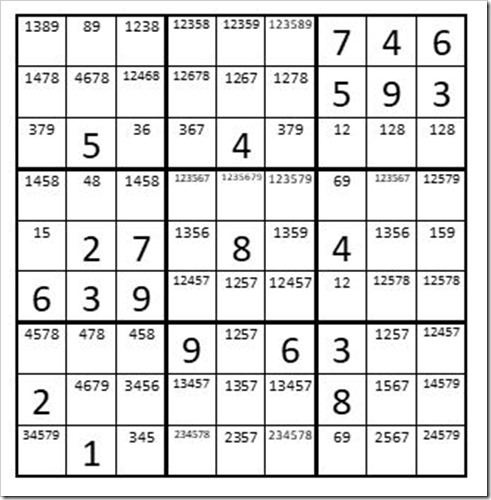
Example #28.4
|
We will next examine the effect of deleting the 6 from C3R9. The only 2 cells in box 7 that contain a 6 are C2R8 & C3R8; therefore 1 of these 2 cells must be a 6. This means that C8R8 cannot be a 6 and we can eliminate the 6 as an option from that cell. This is a Step 2 Interaction. Now your grid should look like Example #28.5 below:
|
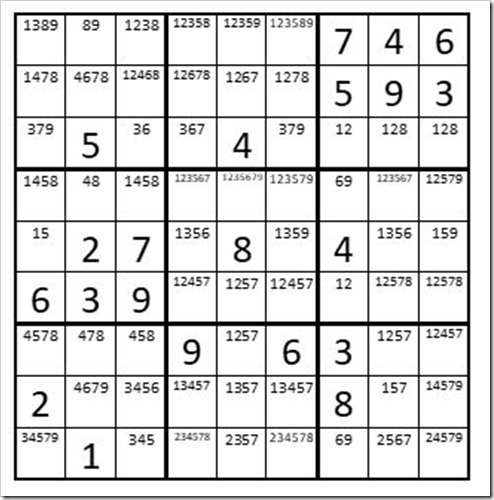
Example #28.5
|
As you continue looking for Step 6 possibilities you have a potential in C2R1 & C2R8 with these cells both containing the option 9 (note there are only 2 cells in column 2 that contain a 2 as an option and they are not in the same box, meeting one of our criteria for a potential Step 6 exercise. As per Example #28.6 below the 2 “starter cells” are highlighted in yellow.
|
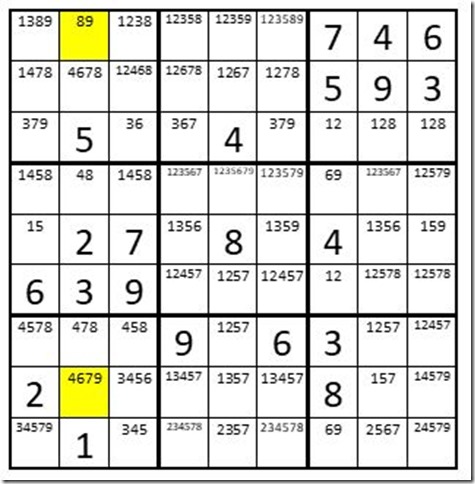
Example #28.6
|
We will first assume C2R8 is a 9 and indicate this by placing a “Y” in that cell. Then C9R8 is a N. We will next assume C2R1 is a 9 and give it a “y”. Then C5R1 & C6R1 are a “n”. C6R3 is a y. C6R4 & C6R5 are a n. C5R4 is a y. C7R4 & C9R4 are a n. C9R5 is a y and finally C9R8 is a n. Now the designation for C9R8 is a N,n meaning that regardless of which cell in column 2 is a 9. C9R8 cannot be a 9, eliminating the 9 as an option for this cell. Now your grid should look like Example #28.7 below:
|
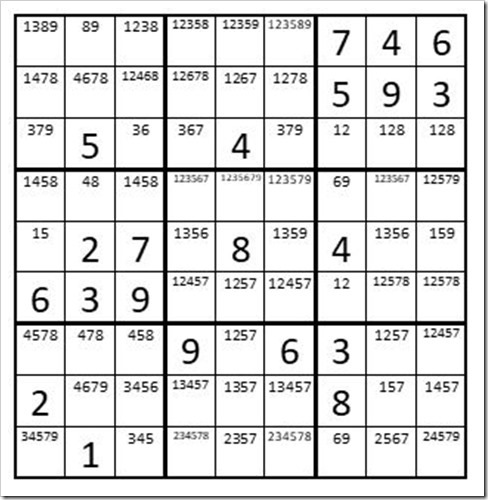
Example #28.7
|
Is this second Step 6 procedure going to help us solve the problem? You be the judge!
Examine row 8. How many unsolved cells have the option 9? Just one. C2R8=9. It then follows that C2R1=8. C2R4=4. C2R7=7. C2R2=6. C3R3=3. C3R8=6. C4R3 =6. C5R4=6. C7R4=9. C7R9=6. C8R5=6. C8R4=3. C9R9=9. C1R9=3. In row 5 C1R5 & C9R5 both have options 15, an obvious pair. Processing this pair means C4R5=3. C6R5=9. Then C6R3=7. C1R3=9. C1R1=1. C3R1=2. C1R5=5. C9R5=1. C7R6=2. C3R2=4. C3R9=5. C3R7=8. C1R4=8. C3R4=1. C4R1=5. C1R7=4. C1R2=7. C6R1=3. C5R1=9. C5R8=3. C5R9 & C8R9 both have options 27, another obvious pair, eliminating the 2 & 7 from C4R9 and the 2 from C6R9. C4R9 & C6R9 form an obvious pair, eliminating the 4 from C4R8 & C6R8. C7R3=1. C9R8=4.
Now your grid should look like Example #28.8 below:
|
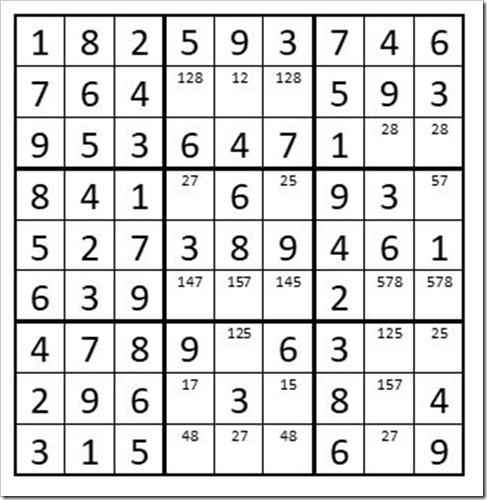
Example #28.8
|
Now we go back to Steps 1-5 again. C9R4 & C9R6 form an Interaction such that the 7 is eliminated from C8R6. C5R7 & C5R9 form an Interaction such that the 2 is eliminated from C5R2. C5R2=1. C8R7=1. Now your grid should look like Example #28.9 below:
|
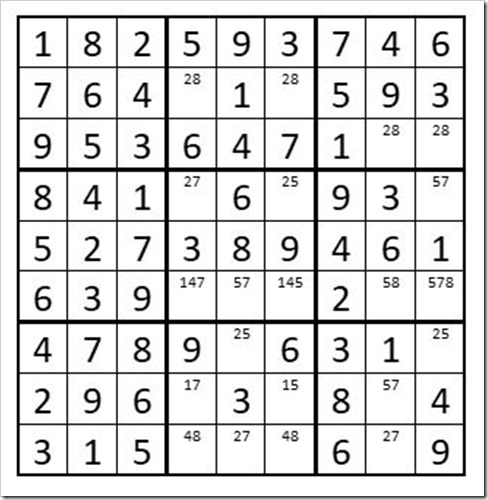
Example #28.9
|
In row 6 we notice that C5R6, C8R6 & C9R6 form a Triplet 578, eliminating the 7 from C4R6 and the 5 from C6R6. C5R7 & C6R8 form a Turbo, eliminating the 5 from C8R6. From this point the puzzle is easily solved, giving us the completed puzzle as per Example #28.10 below:
|
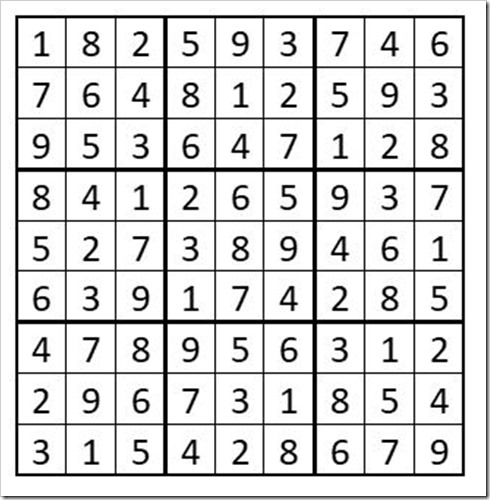
Example #28.10
|
Yes, that was quite a journey! Please note that we simply followed Steps 1-8, needing to revert to previous steps each time we solve a cell or eliminate an option from a cell (s).
Editor’s note:
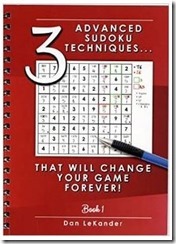 Do you tackle a Sudoku on your cottage veranda, sailboat cockpit, or at a campsite? TI Life is taking full advantage of Dan LeKander, from Wellesley Island, who is a Sudoku expert and author of “3 Advanced Sudoku Techniques – That Will Change Your Game Forever!” Do you tackle a Sudoku on your cottage veranda, sailboat cockpit, or at a campsite? TI Life is taking full advantage of Dan LeKander, from Wellesley Island, who is a Sudoku expert and author of “3 Advanced Sudoku Techniques – That Will Change Your Game Forever!”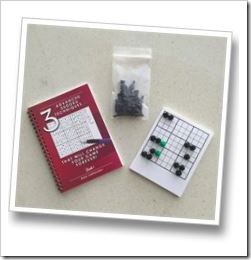
In January 2016, we published a final article in his original series – but many of us enjoy using “Dan’s Steps,” so when he asked if we would like a puzzle to solve every month … this editor said an enthusiastic… Yes, please!
I suggest you try this relatively difficult puzzle and that you also purchase Dan’s book, “3 Advanced Sudoku Techniques, That Will Change Your Game Forever!”
Most importantly, I ask that you leave comments on any part of his series and throughout the year. Remember when your teacher said – no such thing as a silly question – as we can all learn together.
Dan’s book is available online, amazon.com and on ebay.com.
Purchase of a book includes a 50-page blank grid pad, 33 black and two green tokens, to assist with Step 6.…
THANKS Dan and THANKS to his better half, Peggy LeKander, who helps make sure the article is correct and reads well. What a team! Please keep it up….
|
May the gentle winds of Sudoku be at your back!
Dan LeKander
Dan LeKander and his wife, Peggy, have been seasonal residents of Fineview, on Wellesley Island, NY, since 1983. In addition to being a Sudoku addict, Dan explores the 1000 Islands to enjoy the wildlife, beauty and of course, Catch-and Release bass fishing.
[See Jessy Kahn’s Book Review, “3 Advanced Sudoku Techniques…” by Dan LeKander, June issue of TI Life.]